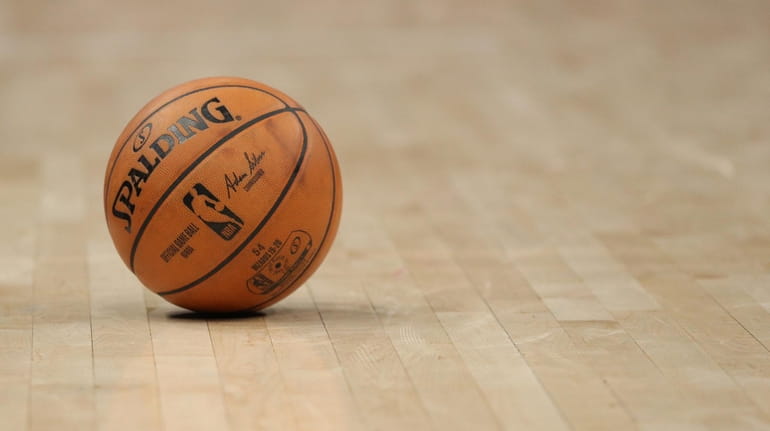NBA players approve plans for restart, but there still are issues to be settled in a COVID-19 world

A general view of an NBA basketball at Capital One Arena on March 10, 2020 in Washington, DC. Credit: Getty Images/Patrick Smith
The NBA took a tentative step forward in a return to play Thursday with the formality of the vote of the Board of Governors to approve the league plan for a restart. But commissioner Adam Silver cautioned just hours later that there are plenty of stairs to climb before the expected restart of a season suspended by the COVID-19 pandemic.
The next step was gaining the approval of the National Basketball Players Association and that came Friday in a conference call. Like the approval of the franchises a day earlier in a 29-1 vote, this was a formality, all 30 player reps approving the plan in a unanimous vote. But the way back is not just the simple matter of the vote.
Some of the issues worked through with the NBPA were the expectations of life in the bubble - from testing protocols for COVID-19, plans for families to be allowed on site after the first round of the playoffs and even a brief exhibition schedule.
The NBPA issued a statement after the vote, which said, “The Board of Player Representatives of the National Basketball Players Association (NBPA) has approved further negotiations with the NBA on a 22-team return to play scenario to restart the 2019-20 NBA season. Various details remain to be negotiated and the acceptance of the scenario would still require that all parties reach agreement on all issues relevant to resuming play."
Silver acknowledged in an appearance on TNT Thursday night that setting the schedule and the plan for a postseason was only the first step with many discussions to come.
“It’s been a very difficult process, and I should say too, to sort of mix sporting metaphors, I would say we’ve got a long way to go here. We’re really in the equivalent of the first inning,” Silver said on Inside the NBA. “The first step was to agree on a format among the 30 teams. We’ve had extensive discussions with the Players Association, but we haven’t finished those negotiations. And they’re obviously our partners here, and so they have to agree to every aspect of this format. So those discussions are ongoing.”
Silver has not left the NBPA out of the talks, discussing the various options for a return not only with union president Michele Roberts, but also in a conference call with players last month. It was in that call that Silver posited to players that if a return would be halted in the case of a player testing positive then there should be no return at all.
The way back has been to put the 22 teams involved in the restart in one bubble-like location at the ESPN Wide World of Sports Complex at Disney World in Orlando. Even that, Silver said, is still a work in progress as he continues to try to navigate the safest path with testing and safety protocols.
“We have issues to work out with Disney in terms of playing with Orlando, but even when all those steps are completed I think there’s constant changes in terms of what we’re learning about this virus,” Silver said. "We’re studying every day the case load in Orange County, in Florida, whether or not antivirals or vaccines come sooner than anyone expected could impact whether fans come in or not.
“So I think that obviously the most significant changes from when we shut down are we’re playing without fans, we’re playing in a central location, we’re going to play on a campus where in essence the players are going to live and remain there throughout the competition. Everyone’s going to be tested. We’re working through the logistics with the players, but most likely daily. And even though the players will be tested on a daily basis and the other participants – other than the time when the players are face-to-face on the court, and an odd thing to do in the time of a virus – the other times we’ll be retaining certain social distancing protocols.
“And I think, one of the things we know, we learned a lot more about the virus since we shut down in March,” he added. “And the data is demonstrating that for the most part, there are exceptions, healthy, young people are the least vulnerable. But there are also people involved in this league, particularly some of the coaches, who are obviously older people. And we also know people at any age who have an underlying condition are vulnerable. So we’re going to have to work through protocol, and it may be for example certain coaches may not be able to be the bench coach. They may have to retain social distancing protocols, and maybe they can be in the front of a room, a locker room, or a ballroom with a whiteboard, but when it comes to actual play we’re not going to want them that close to players in order to protect them. So those are all issues we’re continuing to work through.”
HIs words about older coaches immediately elicited a response from the Coaches Association head Rick Carlisle.
“I just spoke to Adam Silver and he admitted that he jumped the gun with his statement to TNT,” Carlisle told ESPN. "The health and safety of our coaches is first and foremost. It’s entirely possible that an NBA coach in his 60s or 70s could be healthier than someone in their 30s and 40s. The conversation should never be solely about a person’s age. Adam assured me that we would work through this together to help determine what is both safe and fair for all our coaches.”
ESPN reported that Roberts was surprised to see the tentative schedule laid out by the league Thursday, which would include a quick turnaround with the season ending as late as October 12 and restarting with training camp one month later and a regular season opener of December 1. In the call Friday, The Athletic reported that the start date would be negotiated.
--

